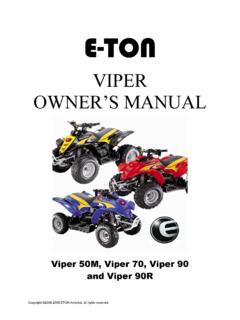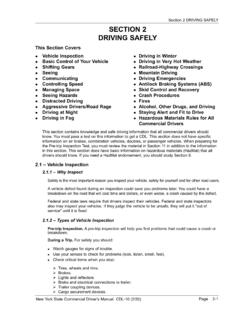Transcription of Design of Surface Mine Haulage Roads - A Manual
1 Page 1 of 49 Information Circular 8758 Design of Surface Mine Haulage Roads - A Manual By Walter W. Kaufman and James C. Ault UNITED STATES DEPARTMENT OF THE INTERIOR Cecil D. Andrus, Secretary BUREAU OF mines WMC Resources Ltd have the expressed permission of the "National Institute for Occupational Safety and Health" to replicate and present this document in Full for use by its employee's. This document was kindly supplied by the: National Institute for Occupational Safety and Health Pittsburgh Research Laboratory Library Box 18070 PITTSBURCH, PA 15236-0070 Page 2 of 49 CONTENTS ABSTRACT.
2 4 INTRODUCTION ..4 Haulage road ALIGNMENT ..4 Stopping Distance--Grade and brake Relationships ..5 Sight Distance ..8 Vertical Alignment ..9 Maximum and Sustained Vertical Curves ..11 Horizontal Alignment ..13 Superelevation Superelevation Sharp Curve Design --Widening on Curves ..15 Combination of Horizontal and Vertical Haulage road CROSS SECTION ..17 Sub Surface Materials ..20 Asphaltic Concrete ..22 Compacted Gravel and Crushed Stone ..23 Stabilized Earth ..25 Haulageway Cross Slope ..27 Conventional Parallel Berms ..27 Traffic Signs.
3 29 Speed Limit Signs ..29 Stop Curve and Intersection Warning Signs ..30 Culvert Crossing Traffic Control Signs ..30 Limited Access Designators ..30 Safety Access Indicators ..30 Drainage Provisions ..30 Ditch Configuration and Location ..30 Ditch Capacity and Culverts ..32 Type and Size ..33 Placement ..34 Inlet-Outlet Controls ..34 Typical Haulageway Page 3 of 49 road MAINTENANCE VEHICLE MAINTENANCE CRITERIA ..39 RUNAWAY VEHICLE SAFETY PROVISIONS ..41 Runaway Vehicle Collision Berms ..42 Escape Lanes ..44 Entrance ..44 Stopping.
4 45 CONCLUSIONS ..46 Page 4 of 49 Design of Surface Mine Haulage Roads A Manual By Walter W. Kaufman and James C. Ault ABSTRACT This Bureau of mines Manual for Design of Surface mine Haulage Roads covers such aspects of Haulage road Design as road alignment (both vertical and horizontal), construction materials, cross slope, and drainage provisions. Traffic control and Design of proper lane widths to promote safe vehicle movement are included, as are suggested criteria for road and vehicle maintenance and for runaway vehicle safety provisions.
5 The aim of this publication is to provide those involved with Surface mine Haulage road Design with a complete Manual of recommended practices that, if implemented, will promote safer, more efficient Haulage routes. INTRODUCTION During the past 30 years, Surface mine Haulage equipment has developed from trucks capable of moving 20 tons of material to vehicles that transport as much as 350 tons. Unfortunately, the Design of Roads this equipment must traverse has not advanced at the same rate. In many areas, road -building technology appropriate to vehicles of three decades past is still being practiced today.
6 As a result, numerous unnecessary Haulage road accidents have occurred every year. A number of these mishaps can be attributed to operator error. However, far too many are caused by road conditions that are beyond the vehicle's ability to negotiate safely. With this history of Haulage related problems in mind, the Bureau of mines undertook a project to produce a Design Manual that would ultimately guide Surface mine road planners toward safer, more efficient Haulage systems. Such a Manual did not exist prior to the conclusion of this project.
7 This Manual was produced under a contract let by the Bureau of mines to Skelly and Loy Engineers and Consultants. Information relating to the content of the Manual was gathered through contacts with mining companies and equipment manufacturers across the country. Review of mining practices in some foreign countries also provided input. Literature sources relevant to good road Design methods were reviewed and listed where appropriate in the text. It is the purpose of this document to identify the performance limitations of modern Haulage equipment and to examine the impact of Haulage road Design on vehicular controllability.
8 Based on these evaluations, Haulage road Design criteria that will promote continuity and safety throughout the Haulage cycle were established. Time allocated for this project prohibited a detailed investigation of mechanical Design for every type of Haulage road user. However, safe road Design criteria should be sufficiently comprehensive to allow application to all machine types. This complication required that Design criteria be based on the one type of Surface mining equipment that exhibits the lowest safety potential. Research of engineering data for all major types of Surface mine machinery revealed that large off the road Haulage trucks had the smallest margin of safety due to their great size and weight, characteristic use, and control components.
9 Thus, designing Haulage Roads to accommodate these vehicles leaves a wide margin of safety for all other Surface mining equipment. Extensive engineering data for all makes and models of large off-the- road Haulage vehicles was solicited from manufacturers. Information was tabulated to identify specifications for width, height, weight, tire track, wheel base, type of braking system , steering ability, retarded performance, speed and range on grade, and numerous other factors for each truck model. Various models were then grouped into four weight range categories, and minimum, mean, and average specifications were identified for each weight category.
10 Design guidelines for each weight category, including velocity stopping distance curves, vertical curve controls, Haulage way widths, curve widening, and spacing of runaway devices, are presented in this report. The Haulage way designer may utilize the Contents section of this report as a checklist to assure that all elements of Design have been considered in planning the Haulage road . Haulage road ALIGNMENT As far as is economically feasible, all geometric elements of Haulage Roads should be designed to provide safe, efficient travel at normal operating speeds.
















